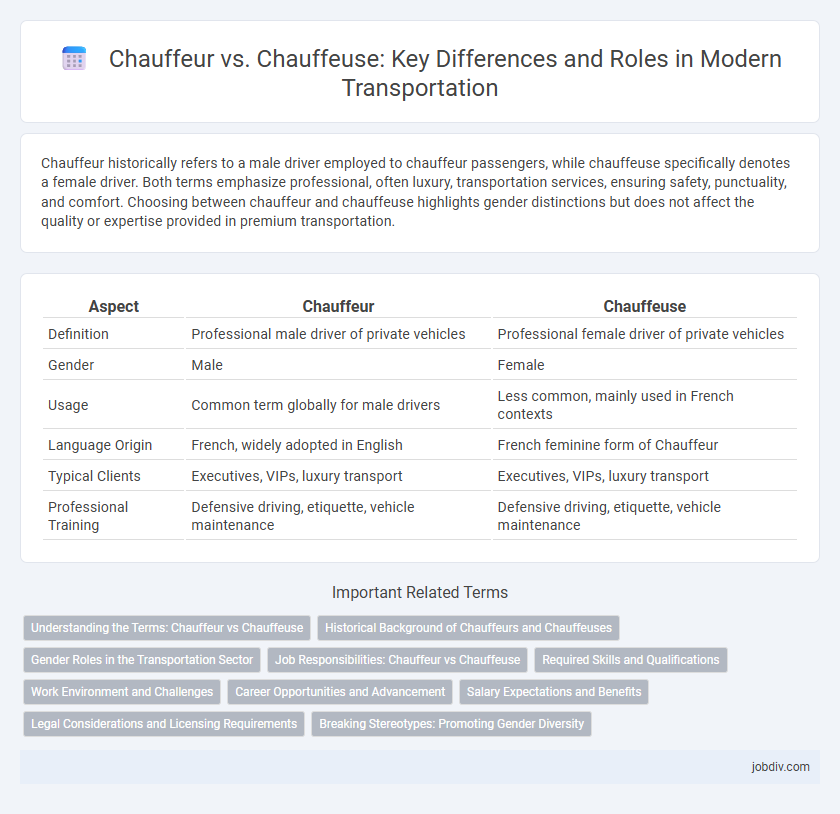Chauffeur historically refers to a male driver employed to chauffeur passengers, while chauffeuse specifically denotes a female driver. Both terms emphasize professional, often luxury, transportation services, ensuring safety, punctuality, and comfort. Choosing between chauffeur and chauffeuse highlights gender distinctions but does not affect the quality or expertise provided in premium transportation.
Table of Comparison
| Aspect | Chauffeur | Chauffeuse |
|---|---|---|
| Definition | Professional male driver of private vehicles | Professional female driver of private vehicles |
| Gender | Male | Female |
| Usage | Common term globally for male drivers | Less common, mainly used in French contexts |
| Language Origin | French, widely adopted in English | French feminine form of Chauffeur |
| Typical Clients | Executives, VIPs, luxury transport | Executives, VIPs, luxury transport |
| Professional Training | Defensive driving, etiquette, vehicle maintenance | Defensive driving, etiquette, vehicle maintenance |
Understanding the Terms: Chauffeur vs Chauffeuse
The term "chauffeur" traditionally refers to a professional driver, usually male, responsible for operating luxury vehicles for clients. "Chauffeuse" is the female equivalent, derived from the French language, emphasizing gender distinction in the profession. Understanding these terms highlights the evolving language use in transportation, reflecting both gender roles and professional expertise behind the wheel.
Historical Background of Chauffeurs and Chauffeuses
The historical background of chauffeurs and chauffeuses traces back to the early 20th century when chauffeurs primarily referred to male drivers employed by wealthy families and aristocrats to operate luxury automobiles. Chauffeuses emerged later as women entered the workforce during and after World War I, challenging gender roles and contributing to the increased presence of female professional drivers. This shift marked a significant evolution in transportation history, reflecting broader social changes and the diversification of the chauffeur profession.
Gender Roles in the Transportation Sector
Chauffeurs traditionally refer to male drivers employed to transport passengers, while chauffeuses denote female drivers, highlighting distinct gender roles within the transportation sector. Despite increased female participation, gender disparities persist, with male chauffeurs dominating executive and luxury transportation services. Efforts to promote gender inclusivity aim to balance representation and challenge stereotypes in professional driving roles.
Job Responsibilities: Chauffeur vs Chauffeuse
Chauffeurs and chauffeuses share core job responsibilities such as safely transporting clients, maintaining the vehicle, and managing schedules, but their roles can vary based on cultural and regional terminologies. Both are tasked with ensuring timely pick-ups and drop-offs, providing personalized service, and maintaining confidentiality during trips. While chauffeur typically refers to male drivers, chauffeuse denotes female drivers, yet the professional duties remain largely identical across both roles.
Required Skills and Qualifications
Chauffeurs must possess a valid commercial driver's license, extensive knowledge of traffic laws, and exceptional driving skills to ensure passenger safety and comfort. Chauffeuses require similar qualifications, including advanced navigation capabilities, proficiency in vehicle maintenance, and strong interpersonal skills to cater to diverse clients. Both roles demand professionalism, discretion, and reliability as essential attributes to maintain high service standards.
Work Environment and Challenges
Chauffeurs and chauffeuses both navigate high-pressure, client-focused environments requiring exceptional driving skills and discretion. Chauffeurs often work longer hours with varying schedules, managing luxury vehicles and ensuring passenger comfort, while chauffeuses face similar challenges compounded by gender biases in a traditionally male-dominated industry. Both roles demand strong time management, adaptability to traffic and route changes, and maintaining professionalism in diverse work settings.
Career Opportunities and Advancement
Career opportunities for chauffeurs and chauffeuses are expanding as demand grows in luxury, corporate, and private sectors, offering roles in executive transportation, event services, and personal driving. Advancement possibilities include progressing to fleet management, becoming a driving instructor, or specializing in high-profile client services requiring enhanced security and discretion. Industry trends highlight the need for professional certifications, customer service skills, and knowledge of advanced vehicle technology to succeed in competitive markets.
Salary Expectations and Benefits
Chauffeur salaries typically range from $40,000 to $70,000 annually, with premium positions offering higher compensation based on experience and location, while chauffeuses often receive comparable pay scales reflecting industry parity. Benefits frequently include health insurance, retirement plans, paid time off, and sometimes access to company vehicles, enhancing overall compensation packages. Awareness of regional demand fluctuations and employer type can influence salary expectations and benefit offerings for both chauffeurs and chauffeuses.
Legal Considerations and Licensing Requirements
Chauffeurs must obtain a commercial driver's license (CDL) or a specialized chauffeur's license depending on regional regulations, ensuring compliance with strict background checks and driving record evaluations. Chauffeuses, as female professional drivers, are subject to the same legal considerations and licensing requirements, including mandatory training and certification standards aimed at passenger safety and liability coverage. Both roles require adherence to local transportation laws, insurance mandates, and periodic renewal of licenses to maintain operational legitimacy.
Breaking Stereotypes: Promoting Gender Diversity
Chauffeurs and chauffeuses both provide professional driving services, challenging traditional gender roles in transportation by demonstrating equal competence and reliability. Emphasizing gender diversity in chauffeur services promotes inclusivity and broadens employment opportunities beyond stereotypes. Companies adopting gender-neutral hiring practices contribute to breaking down barriers and fostering a more equitable transportation industry.
Chauffeur vs Chauffeuse Infographic

 jobdiv.com
jobdiv.com